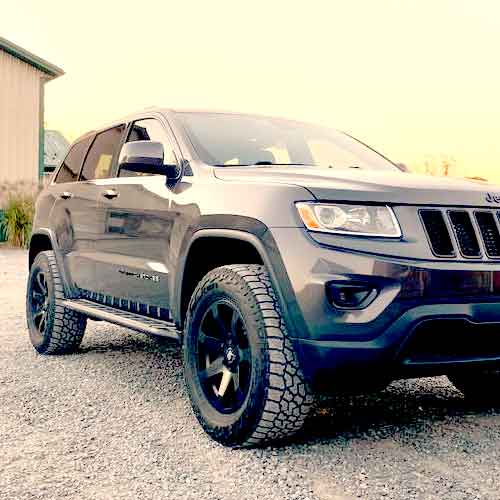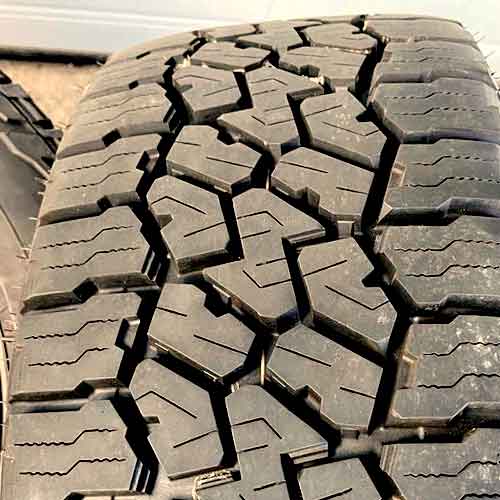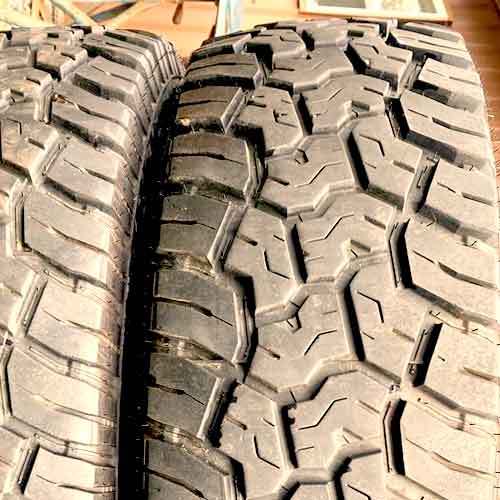Both the Yokohama Geolandar X-AT and the Falken Wildpeak AT3w which provide you with the best of both worlds – excellent off-road performance and smooth, confident handling on the road, yet there are a lot of key differences that make them both very unique.

Being a driver of both of these tires, I can tell that comparatively, the Falken Wildpeak AT3w does better on highways, with far superior traction on wet roads. It’s yields amazing on-road comfort, fuel economy, tread longevity and winter traction capabilities. The Yokohama X-A/T on the other side, does better on rugged terrains with its more efficient self cleaning tread, so you get superior mud and dirt traction. It’s rock climbing performance is also pretty impressive as well, and on snow, it does not lack too much and carries 3PMSF rating like the Falken AT3w.
Internal Construction
The durability of an all-terrain tire is largely determined by its internal construction, specifically the construction of the sidewalls.
The Yokohama Geolandar X A/T offers 3 ply sidewalls (along with 2 steel belts and a single nylon cap ply).
(Review Yokohama’s tire here).
And Falken Wildpeak AT3w on the other hand, gives you 2 ply sides, with 2 extra bead plies acting as reinforcements (with 2 belts and nylon cap plies).
So this makes both tires pretty great here, though still you can say it’s amazing that Falken AT3w being a less aggressive tires is offering similar durability (if not more).
Sizes Info
| Falken Wildpeak AT3w | Yokohama Geolandar X A/T | |
| Total Sizes | 76 | 46 |
| Rim Sizes | 15″ to 22″. | 15″ to 22″. |
| Speed Ratings | Q, R, S, T and H. | Only Q. |
| Load Ratings | SL, XL, C, D, E, and F. | C, D, E and F. |
| Weight Range | 35 lbs to 79.4 lbs | 40 lbs to 83 lbs. |
| Tread Depth | 12 to 19/32″. | 16 to 19/32″. |
| Mileage Warranty | 55k miles | 45k miles. |
Tread Appearance
With a more closed up design the Falken Wildpeak AT3w forms narrower grooves, yet they are still very effective.

Starting form the middle, the tire offers Z shaped blocks of slightly bigger proportion (which helps the tire in directional traction).
These lugs have chamfered edges, rectilinear (full depth sipes) and stepped edges on sides, whereas, the surrounding ribs have similar siping design, but you also see notches on them facing in all directions, as well.
All these lugs are compactly separated by wide longitudinal grooves (of zigzag shapes) from the shoulders.
These shoulder lugs cover most of the tread’s area and they are equipped with notches and stepped edges like seen in the middle.
Though the siping is very different here as it forms a wave-like pattern offering superior wet handling.
Moreover, towards outer edges, the tire although is not staggered, it offers very sharp edges which then join together to form U shaped sidewall lugs, though they are not as thick, comparatively.
The Yokohama Geolandar X-AT offers a hybrid tire, on the other hand, and has prominent shoulder lugs on the sides with wider tread voids compared to the middle.

The center of the tire has L and S shaped ribs with notches and full depth sipes, that become thicker towards the edges.
The thinner sipes are for water, while the thicker ones aid in snow evacuation.
The combination of four ribs creates straight lateral grooves connecting the outer, more open voids of the shoulder lugs, resulting in a self-cleaning tread.
The shoulder lugs are surrounded by stone/dirt ejectors on all sides, including in the open circumferential channels they form, enhancing the tire’s cleaning abilities.
The lugs also have a similar siping pattern and extend towards the sidewalls, forming sharp edges, but do not have any notches.
Now using both tire’s structure and design, it’s much easier to understand how they performed in all below sections.
Pavement Performance
When evaluating the dry performance of all-terrain tires, there are three key factors to consider: straight grip, steering, and sideways grip.
Let’s examine each of these in turn.
Dry Grip
Tire’s grip is largely determined by the central area of the tread, which should have as much contact with the road as possible for optimal grip, or should I say directional grip (measured with braking distances).
The Yokohama Geolandar X A/T lacks here by a lot, comparatively.
Its lugs are sloppy with huge tread depth and no supports (underneath them) and it’s wider grooves eat away the space that could have been in contact with the surface.
Contrarily, Falken Wildpeak AT3w has compactly arranged lugs and although, this tire also features a lot of tread depth, the blocks stay firm as they have ridges supporting from multiple sides, resulting in shorter braking distances.
Lateral Traction
Lateral traction, or the tire’s ability to corner, is largely determined by the shoulder lugs, as they bear the majority of the (vehicle’s) weight during turns, and need to have a strong bond with the road to maintain traction.
Yokohama Geolandar X-AT again lacks here as well with its unsupported lugs distorting over corners with (tire’s) heavier weight as the vehicle turns.
Falken AT3w on the other side, has a stable foundations over there as well, it’s shoulder lugs also run in pairs as they are joined together from the sidewalls, forming U shaped lugs. That’s why its offers superior handling times as well.
Steering Sensitivity
Tire responsiveness is a measure of how well a tire responds to steering inputs and can be influenced by factors such as weight and sidewall’s design, which can affect the continuity of contact between the tire and the road.
Yokohama Geolandar X-AT, being a balder tire can not make as continuous of a contact as the Wildpeak AT3w so its not surprising that it lacks here as well.
That’s why it yields limited speed rating of only Q, whereas Falken’s boy offers up to H (the highest you can get in A/T category).
Wet Traction
On wet roads, it’s important for a tire to have both good grip and hydroplaning resistance in order to quickly clear water from the surface.
Wet Grip
The wet grip of a tire is largely determined by its siping, which helps to absorb water and improve traction. It’s important for the sipes to be flexible in order to allow for efficient water cleaning.
Yokohama Geolandar X-AT although offers a softer rubber composition, the limited sipes on the tire do not produce the appreciable results.
On the other side, the Falken AT3w with it’s dual siping design offers not only superior traction in comparison here, but it’s one of the best you can get compared to other A/T tires as well.
(That’s why I added this tire on top of my list of “performing” all-terrain tires.
Aquaplaning
The risk of hydroplaning increases at higher speeds, so it’s important to have good resistance in order to maintain controls on wet pavements.
Yokohama Geolandar X-AT being a more voided tire has no trouble with it, and one might say its an overkill for this.
Whereas the Wildpeak AT3w has a great balance between the grooves and the lugs, and it makes a streamlined path for water to gush out in an effective way.
Fuel Consumption
The fuel economy of a tire is influenced by its rolling resistance, which depends on a lot of factors, which include, weight, tread depth, and tread composition.
Though both tires have similar weight and tread depth (across all sizes, almost), and they are both pretty soft, the Falken Wildpeak still does better, because of it’s supporting ridges and chamfered edges.
With supporting ridges, the lugs are kept in the place, and with this, they don’t move more than required. This allows it to have less stickiness on the surface, so less rolling resistance is generated. Similarly, with chamfered edges, the lugs don’t push each other during sporty braking/handling.
On the other side, the Yokohama with its unsupported lugs and a lot of gaps in between, wastes a lot of energy in flexing rather than moving.
Mileage
The mileage is linked with tread wear which is also dependent on the rolling resistance, but here pressure has a bigger role to play.
And to put more specifically, pressure on each lug.
Though both tires have similar tread depth and a softer composition, the Falken Wildpeak AT3w with it’s closed up lugs, evenly distributes its weight across its’ blocks.
Whereas the same amount of weight is divided on less surface area of the lugs on Yokohama X A/T. so it makes sense why it wears off faster, each lug has more pressure on it, comparatively.
Though Geolandar G016 is still pretty good, considering its a rugged terrain tire, and that it offers 45k miles warranty (Falken offers 55k).
Ride Comfort
A tire with good ride quality should be able to minimize road noise and effectively dampen vibrations.
Both tires have noise reduction technologies, such as pitch sequencing, which aim to minimize the amplification of sound by altering the tire’s geometry.
You see, noise is just air particles hitting the tread, and with variations in geometry, those hitting particles generate various tones on different part of the tread, and so all sound waves are not able to sync together.
But still, Falken AT3w is a silent tire in comparison, as it does not invite a lot of air to get in, with it’s more closed up grooves.
Yokohama Geolandar X-AT on the other side, has a lot of playground room for air particles to dance around.
But the good thing is that the tire is pretty thick and it offers a great bumps absorption abilities, dissolving the imperfections of the road in its tread.
Falken AT3w lacks in this area, with it’s one extra cap ply, which brings more rigidity in comparison.
Winter Capability
Both of these tires tend to perform well on snow due to their inclusion of winter tire features such as soft rubber compound (composition), numerous sipes, and deep notches that can help grip snow.
But still out of them only Falken Wildpeak AT3w carries 3 peak mountain snowflake rating (with which it can legally enter the areas with severe snowy conditions).
The tire is better because it’s full depth interlocking sipes and closed up notches chew the snow with more biting power.
Yokohama Geolandar X-AT on the other side, does better with deeper terrains, with it’s wider grooves. That’s because on lighter terrains, it’s tread voids and biters are not able to trap in the snow.
And it’s crucial because on this terrain you need to make snow to snow contact to enhance the grip.
Off Road Performance
When driving on rougher terrains, there are several factors that can impact the overall performance. And to find them, we have to discuss these terrains separately.
Starting with mud.
Thick Mud
Yokohama Geolandar X-AT being a hybrid does better here. That’s because its tread contains mud-terrain shoulder lugs on sides, with bigger mud scoops, surrounded with wider gaps.
So being more voided, it’s able to keep it’s tread clean, and it’s bigger traction scoops are able to spoon out more mud in comparison.
Falken Wildpeak on the other side, does have staggered shoulder lugs, but the tire is still pretty great compared to other less aggressive options, as it offers deepest tread in the category (on A/Ts).
On Rocks
On rocks you need biters and powerful sidewalls (from both inside and out).
In terms of sidewalls, both are pretty though internally, but on the outside, as the Yokohama Geolandar X-AT offers thicker lugs, they protect the sides more and allow the tire to have slightly better lateral traction (with lowered tire’s air pressure).
The softer lugs of this tire also allows (bigger) flexing mouth to chew on rocks, and the notches further enhance those tractional forces.
Falken Wildpeak AT3w, alternatively, is also pretty great and lacks only marginally, as its slanted U shaped sidewall lugs also produce significant traction, and it’s sharp steeped edges on shoulder lugs offer a considerable lateral traction.
Also in the middle with notches facing everywhere, it ensures grip in all directions.
On Sand
Sand requires a tire that is lighter in weight and has smooth edges to avoid digging (which is how you get stuck).
Falken Wildpeak AT3w only has one issue, it’s sides are very sharp. And if we combine this with it’s weight, it makes sense why its a digger, especially on deeper terrains.
The Yokohama X AT on the other hand, has softer composition and it’s smoother towards edges, and so additionally providing larger footprint, it focuses on moving forward more.
To Sum Up
Yokohama Geolandar X-AT being a hybrid terrain is able to pull off more on rocks, mud, sand, basically nearly all off-road terrain types.
Though the tire is lacking on highways, and that’s where Falken Wildpeak AT3w comes in. It’s one of the most efficient tires out there, that are great on dry/wet pavements with surprising off road capabilities.
It offer all season traction in a better way, with it’s superior more resistant thermal adaptive rubber, earning it with sever snow rating.